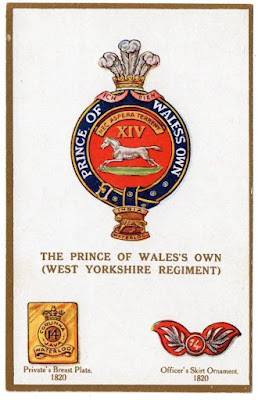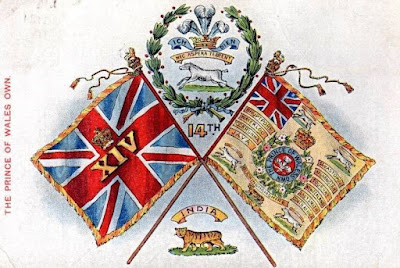Having recently posted three separate posts on regimental numbering in the 3rd (Special Reserve) Battalion, 4th (Extra Reserve) Battalion and 5th (Extra Reserve Battalion) of the Royal Munster Fusiliers (RMF), I thought it would be helpful to illustrate the problems we face when trying to work out when our RMF ancestor joined the regiment - and which battalion he joined.
Between 1908 and 1914, men joining the 1st and 2nd Battalions would have been issued with numbers in the approximate range 8700 to 10320. For men joining the 3rd Battalion, the number range was approximately 3000 to 4500, for the 4th Battalion it was 4000 to 7300 and for the 5th Battalion it was 5300 to 6100. I stress that these number ranges are approximate.
So if you know your RMF ancestor earned the 1914 Star and had the regimental number 4300, he could have originally joined the 3rd or 4th Battalion. For that matter, it's also possible that he was an older soldier who had originally joined the 5th (Militia) Battalion pre-1908. If he was in fact a career soldier, he would have had to have joined the RMF in 1893.
Take a look at the 1914 Star medal roll extract on this post. The 3rd Battalion only reached the 5100s by December 1914. For the 4th Battalion, they reached the 7600s, and the 5th Battalion was in the 6600s. This means that a man with a number higher than 7700 must have been a career soldier and must have originally served with the 1st or 2nd Battalion.
Ten of the 12 men on this extract must therefore have been career soldiers. So that leaves 6093 Walton and 7202 Crowe. Walton could have enlisted with the 4th or 5th Battalions, but not the 3rd. Crowe could have enlisted with the 4th, but not the 3rd or 5th Battalions. For that matter, both men could have been early regular enlistments - see my post on numbering in the 1st & 2nd Battalions - with Walton potentially joining the regiment in 1898, and Crowe joining in 1902.
In such cases, you'd be hoping for a service record or a record in MH 106 (hospital admissions) to provide additional information about these men's length of service. My own hunch, without having researched these two men further is that they probably were long-serving career soldiers, given that they arrived overseas on the 13th August 1914 along with the majority of the other men on this roll.

.jpg)








